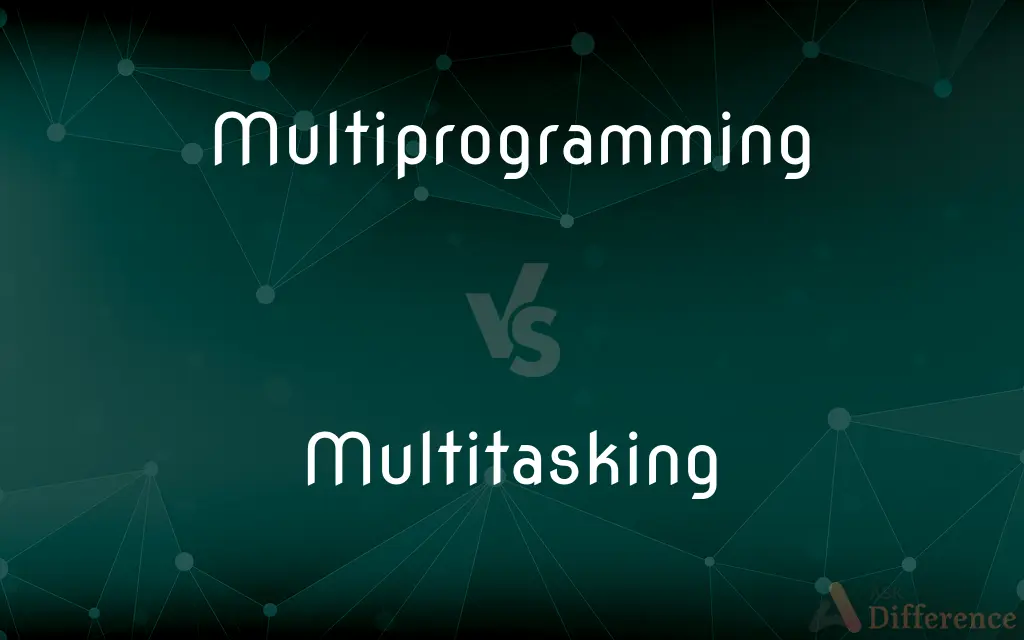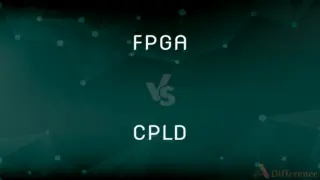Multiprogramming vs. Multitasking — What's the Difference?
By Tayyaba Rehman — Published on January 3, 2024
Multiprogramming involves multiple programs running concurrently on a single CPU, sharing resources efficiently. Multitasking refers to a system executing multiple tasks or processes at once, rapidly switching among them.

Difference Between Multiprogramming and Multitasking
Table of Contents
ADVERTISEMENT
Key Differences
Multiprogramming is a method where multiple programs are loaded into memory and executed by the CPU simultaneously. This technique optimizes the use of CPU resources by ensuring that the CPU is always busy processing one program while others wait for I/O operations. Multitasking, on the other hand, refers to the ability of an operating system to manage multiple tasks or processes simultaneously. It involves the rapid switching of the CPU among different tasks, giving the illusion that the tasks are running concurrently.
In multiprogramming, the focus is on maximizing CPU utilization by having multiple programs reside in memory at the same time. The operating system decides which program gets the CPU's attention, usually based on a scheduling algorithm. Multitasking extends this concept by not only managing multiple programs but also various processes within those programs. It is more about efficiently managing time and resources so that user interactions and system processes seem seamless and uninterrupted.
Multiprogramming environments are primarily designed to increase the efficiency of batch processing systems where the interaction with users is minimal. It is more about throughput and resource utilization. In contrast, multitasking is essential for interactive systems where user engagement and responsiveness are critical. It enables a user to interact with one program while others continue running in the background, thus enhancing the user experience.
While multiprogramming is heavily dependent on how the programs are scheduled and executed in sequence, multitasking emphasizes the importance of time-sharing. In multitasking systems, each task receives a small time slice of the CPU, ensuring all tasks are addressed periodically. This approach is crucial in modern operating systems, which need to handle various simultaneous user requests and system operations efficiently.
Overall, both multiprogramming and multitasking are fundamental concepts in operating systems, each serving distinct yet complementary roles. Multiprogramming lays the groundwork for efficient use of the CPU by handling multiple programs, while multitasking builds upon this to deliver a responsive and efficient user and system interaction by handling multiple tasks concurrently.
ADVERTISEMENT
Comparison Chart
Focus
Maximizes CPU usage by running multiple programs simultaneously.
Manages several tasks within these programs, rapidly switching between them.
System Type
Common in batch processing systems, less interactive.
Essential for interactive systems, enhancing user experience.
Resource Management
Efficiently utilizes CPU by keeping it always busy.
Efficiently manages both CPU time and user/system interactions.
User Interaction
Minimal user interaction; more focus on throughput.
High level of user interaction, with tasks appearing to run in parallel.
Scheduling
Programs are scheduled for execution, often based on priority.
Tasks are allocated time slices for execution, ensuring responsiveness.
Compare with Definitions
Multiprogramming
Multiprogramming is a technique where several programs are executed by a single processor.
In multiprogramming, while one program waits for I/O, the processor executes another program.
Multitasking
It enhances user experience by allowing interaction with multiple applications concurrently.
Thanks to multitasking, she could chat with friends while working on her presentation.
Multiprogramming
It optimizes CPU usage by handling multiple program executions simultaneously.
Multiprogramming increased the company's server efficiency, allowing more programs to run without additional hardware.
Multitasking
Multitasking is the ability of an operating system to execute multiple tasks simultaneously.
Her computer's multitasking capabilities allowed her to browse the web while running a virus scan.
Multiprogramming
Multiprogramming enables efficient processing of batch jobs in computing environments.
Through multiprogramming, the university's computer could handle numerous research simulations concurrently.
Multitasking
Multitasking ensures efficient management of CPU time among various processes.
The server's multitasking feature enabled it to handle numerous user requests without delays.
Multiprogramming
Multiprogramming involves managing multiple programs in a single processor’s memory.
The mainframe computer utilized multiprogramming to process several batch jobs overnight.
Multitasking
It involves rapidly switching between tasks to give the impression of parallelism.
Multitasking on his laptop made it possible to edit documents and play music at the same time.
Multiprogramming
It focuses on maximizing resource utilization by reducing idle CPU time.
Multiprogramming effectively reduced CPU idle time in our legacy systems.
Multitasking
Multitasking is crucial for responsive and interactive computer systems.
The game console's multitasking ability let players switch between games and online streaming effortlessly.
Multiprogramming
(computing) The allocation of computing resources to more than one concurrent application, job, or user.
Multitasking
The concurrent operation by one central processing unit of two or more processes.
Multiprogramming
The execution of two or more computer programs by a single computer
Multitasking
The engaging in more than one activity at the same time or serially, switching one's attention back and forth from one activity to another.
Multitasking
Present participle of multitask
Multitasking
(computing) The simultaneous execution of multiple tasks (programs) under the control of an interrupt-driven operating system.
Multitasking
The practice or capability of handling more than one task at the same time.
Common Curiosities
What is Multiprogramming?
It's a method where multiple programs are executed by a single processor, optimizing CPU usage.
Does Multiprogramming increase throughput?
Yes, it maximizes CPU utilization, thus increasing throughput in computing environments.
What is Multitasking?
Multitasking refers to an operating system's ability to manage and execute multiple tasks simultaneously.
Can a system be both Multiprogramming and Multitasking?
Yes, modern operating systems often incorporate both concepts for optimal performance.
Is Multiprogramming suitable for interactive systems?
No, it's more suited for batch processing systems with minimal user interaction.
Can Multitasking improve user experience?
Yes, it allows users to interact with multiple applications seamlessly, enhancing the user experience.
How does Multiprogramming differ from Multitasking?
Multiprogramming focuses on running multiple programs on a single CPU for efficiency, while multitasking manages multiple tasks within these programs for responsiveness.
Is Multiprogramming still relevant today?
Yes, especially in systems where maximizing CPU usage and processing efficiency is critical.
How does scheduling work in Multiprogramming?
Programs are scheduled based on priority or resource availability, ensuring efficient CPU usage.
How does Multitasking affect CPU usage?
It efficiently manages CPU time by rapidly switching between tasks, ensuring responsive system performance.
Does Multitasking require special hardware?
Not necessarily, but a more powerful CPU and adequate memory can enhance multitasking capabilities.
Can Multiprogramming handle real-time processing?
It's less suited for real-time processing due to its focus on throughput rather than responsiveness.
Are there any drawbacks to Multiprogramming?
It can lead to resource contention and requires efficient memory management to prevent bottlenecks.
How does Multitasking impact system responsiveness?
By rapidly switching between tasks, multitasking ensures the system remains responsive to user inputs and system events.
What role does time-sharing play in Multitasking?
Time-sharing allocates specific time slices to tasks, ensuring all tasks are addressed regularly.
Share Your Discovery

Previous Comparison
Alcohol Thermometers vs. Mercury Thermometers
Next Comparison
FPGA vs. CPLDAuthor Spotlight
Written by
Tayyaba RehmanTayyaba Rehman is a distinguished writer, currently serving as a primary contributor to askdifference.com. As a researcher in semantics and etymology, Tayyaba's passion for the complexity of languages and their distinctions has found a perfect home on the platform. Tayyaba delves into the intricacies of language, distinguishing between commonly confused words and phrases, thereby providing clarity for readers worldwide.












































